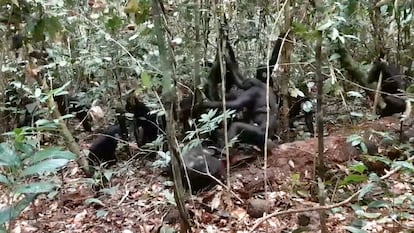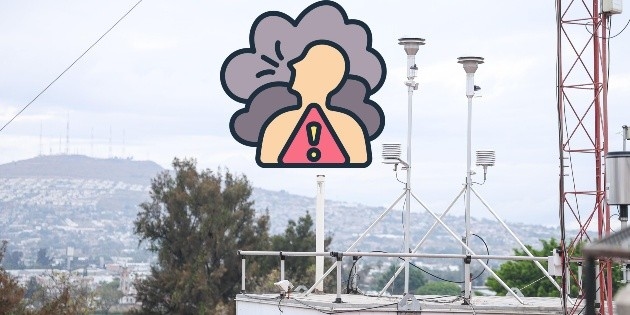The five bonobas that killed a male challenge the myth of the pacifist species: "The most violent attack ever observed."

No one has seen Hugo since February 18, 2015. That day, at 3:30 p.m., a scream was heard in the middle of theSalonga forest in the Democratic Republic of the Congo. Two minutes later, the first human witness arrived and started recording. Five females, Polly , Tao , Ngola , Djulie , and Bella , were beating up this almost twenty-year-old male, who was lying face down on the ground.
The attack lasted an endless 25 minutes for Hugo , who covered his head as best he could while the entire clan watched the scene without intervening, including some of his relatives. “The females jumped alternately on Hugo ’s body, stomping on his back and biting his head, legs, neck, fingers, and toes. One of them bit off part of his ear; two others rubbed their genitals against each other on top of him. One of the attackers bit his foot and chewed the torn tissue, then bit his testicles,” the scientists who have now published the case describe in detail.
Hugo's face was disfigured, bleeding from his lips and eyebrows, a large section of skin had been torn from his neck, his knuckles had been bitten to the bone, and he suffered severe injuries to his testicles and penis. He barely managed to flee the scene two hours later. "He's still missing, and we're pretty sure he didn't survive," says Sonya Pashchevskaya , a primatologist and direct witness to an attack that serves to nuance the complexities of a species idealized as erotic-festive hippies: bonobos.
Their reality helps us interpret the evolutionary mosaic that we great apes comprise: humans, orangutans, gorillas, chimpanzees, and bonobos. These last two species, the closest to us , are a kind of mirror game. Male chimpanzees rule the social hierarchy with an iron fist and form lasting bonds among themselves, while they are violent with females to secure offspring . Bonobos live in a matriarchy: females dominate the group through alliances that, among other behaviors, they reaffirm by mutually rubbing their vulvas ( seeking pleasure with their clitorises ).

Ever since Jane Goodall watched in terror the cruel wars between chimpanzees , bonobos have always been idealized as the pacifist opposite, especially after the popular books of Frans de Waal . “Although it's true that they are much more peaceful,” Pashchevskaya clarifies, “the hippie image of bonoba society largely comes from captive populations.” Wild bonobos are less idyllic, as this researcher from the Max Planck Institute (Germany) explains. “The peaceful bonoba society, which is maintained by females assuming dominance over males, can occasionally be interrupted by extreme events like this, which would be the exception that proves the rule.”
Males are bigger and stronger; violence, as a tool of social control, is wielded by women. And perhaps that's why it has gone more unnoticed. "It reflects a very male-centric view," admits Martin Surbeck, who has also worked with the bonobos of Lui Kotale, in Salonga National Park , although not in this study. Surbeck, of Harvard University, published a study in April that reviews thirty years of observations to understand the power of bonobas. Eighty-five percent of violent coalitions are led by females trying to keep males in line, so the ferocity is clearly functional: to prevent them from becoming chimpanzees. In certain communities, 100% of conflicts are won by females, demonstrating that dominance is structural.
Social power, not physical power“The power of these female coalitions is one of the main mechanisms that reverses the power dynamics between the sexes within bonobo groups,” Surbeck added via email. When bonobas form aggressive alliances to exert social control over males, they demonstrate that power can be derived not from physical strength, but from social support.
That's where the attack by the five females on Hugo begins to make sense. According to primatologists who follow that community, a couple of days earlier this male had made an aggressive gesture towards the offspring of the youngest of the attackers, Bella (15 years old). Infanticide is a common tool used by males of many species to ensure reproductive success: I have children when the female no longer cares for the children she had with others. "Bonobo females, however, have managed to reverse that trend, which chimpanzees do comply with, thanks to an unusual cooperation between them,” explains Pashchevskaya, “and they even attack males who misbehave with their young.” “Extreme violence would be better explained as a response to the extreme threat: infanticide,” summarizes the lead author of this case detailed in the journal Current Biology . A similar case occurred years ago, although less well documented. The primatologist acknowledges that they can only speculate, explaining: “Why don’t infanticides occur within the group among bonobos? Because this is what happens if a male tries it.” If females are capable of carrying out an act of violence of such magnitude against an adult male, continues the scientist, perhaps that is precisely what keeps male aggression like that of chimpanzees at bay.
Nahoko Tokuyama, another bonoba expert , is “very surprised” by the episode. “Although they sometimes become violent, I thought female bonobos wouldn’t injure an opponent so seriously,” she says. “I think Hugo provoked the females particularly severely. Aggression against an infant constitutes a serious violation of bonoba society norms and almost always provokes retaliation from the females,” adds Tokuyama of Tokyo Central University, author of several studies on wild bonoba coalitions. “This case certainly represents the most violent attack ever documented in bonobos,” she concludes.
Wounded penises and friendly vulvasAs for the symbolism of the more gruesome details, experts on this species are cautious. The wounds on Hugo 's genitals, for example. Chimpanzees that attack males from other groups often attack there, in part to eliminate reproductive competition . "They're an easy area to damage when you're just using your teeth and hands, so it would be wise not to attribute too much symbolic meaning to them," Pashchevskaya cautions. But she adds: "Perhaps it communicates something like 'don't overstep your bounds.'"
Females rubbing their genitals against the victim's body would be more common. Bonobas do this a lot, to forge those bonds of sisterhood that, on a social scale, end up forming a matriarchal network. "They also do it when they meet again after a while, as a kind of 'hello, nice to see you,'" Pashchevskaya points out. Liza Moscovice , author of several studies on bonobas and their sexual behavior , elaborates: "It's common in tense situations, such as during coalition attacks. Genital rubbing helps females coordinate their behavior, confirm mutual support, and possibly reduce stress in tense moments." Tokuyama indicates that "they were probably trying both to relieve stress and reaffirm their cooperative bond with each other." "In short, in this case," concludes the lead author of the study on Hugo 's death, "genital rubbing facilitates cooperation: 'I'm with you on this.'"
EL PAÍS





